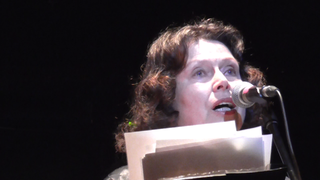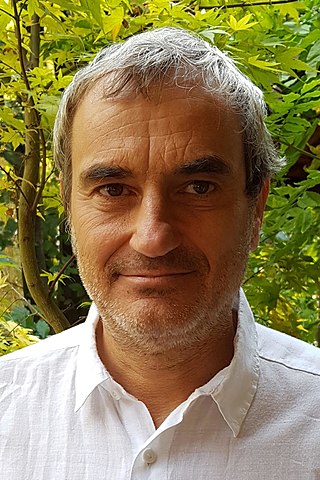
Tomaž Šalamun was a Slovenian poet who was a leading figure of postwar neo-avant-garde poetry in Central Europe and an internationally acclaimed absurdist. His books of Slovene poetry have been translated into twenty-one languages, with nine of his thirty-nine books of poetry published in English. His work has been called a poetic bridge between old European roots and America. Šalamun was a member of the Slovenian Academy of Sciences and Arts. He lived in Ljubljana, Slovenia, and was married to the painter Metka Krašovec.

Mangelos was a Yugoslavian artist, curator and art critic whose artistic production included handmade books, sculptures and paintings. His work and research contributed greatly to the development of abstract art in Croatia.

Miško Šuvaković is a contemporary aestheticist, art theorist and conceptual artist in Belgrade, Yugoslavia. He taught theory of art and theory of culture in Interdisciplinary Postgraduates Studies at the University of Arts in Belgrade. He teaches theory of art and theory of culture in transdisciplinary master and doctoral studies at the Faculty of media and communication.
Lela B. Njatin is a Slovene writer and visual artist. She is best known for her novel Nestrpnost (Intolerance) and her conceptual art installations.

Croatian art of the 20th century, that is visual arts within the boundaries of today's Croatia, can be divided into modern art up to the Second World War, and contemporary art afterwards.

Zoran Mušič, baptised as Anton Zoran Musič, was a Slovene painter, printmaker, and draughtsman. He was the only painter of Slovene descent who managed to establish himself in the elite cultural circles of Italy and France, particularly Paris in the second half of the 20th century, where he lived for most of his later life. He painted landscapes, still lifes, portraits, and self-portraits, as well as scenes of horror from the Dachau concentration camp and vedute of Venice.

Un Coup de Dés Jamais N'Abolira Le Hasard is an artist's book by Marcel Broodthaers published November 1969 in Antwerp. The work is a close copy of the first edition of the French Symbolist poet Stéphane Mallarmé's poem of the same name, published in 1914, but with all the words removed, replaced by black stripes that correspond directly to the typographic layout used by Mallarmé to articulate the text.
Broodthaers reduces Un Coup de Dés to its structure - or to put it another way he elevates the structure of the work to a concept worthy of study in its own right, thus acknowledging Mallarmé's own fetishistic attention to this aspect of his work. Rendering the structure concrete, visible, almost tactile, Broodthaers offers a conceptual analysis of Mallarmé's poem across the distance of a nearly a century...It would be hard to imagine a more subtle treatment of Mallarmé's work, or one more capable of demonstrating its essential properties, than this reworked book by Broodthaers. — Johanna Drucker
The Marinko Sudac Collection, based in Zagreb, Croatia, has been created with a clear collecting strategy based on the region of Central and Eastern Europe, additionally spanning from the Baltic area to the Black Sea. The guiding principle of the Collection is systematic exploration, researching, and promotion of the avant-garde practices which have been marginalized, forbidden, and at times completely negated due to the historical, social and political circumstances. In this context, the Marinko Sudac Collection gives the most complete and comprehensive overview on the art of this region. The Collection starts at 1909, and it show the continuity from the first Avant-Gardes, through neo-avant-garde and New Artistic Practices, ending with the fall of the Berlin Wall. The global uniqueness of the Marinko Sudac Collection is also seen in the kind of media it contains. It contains not only traditional artworks, such as paintings, sculptures, and photographs, but it gives equal importance to documentary and archival material. Great importance is put on these almost forgotten media, which enable research of specific phenomena, artists and the socio-political situation which affected this type of art. The Collection contains a great number of museological units, and it treats the documentary and archival material on the same level as traditional artworks. By examining the units contained in the Marinko Sudac Collection, one can read not only the art scene or the art production of a certain artist, but the full status of the society, the socio-political atmosphere of the region in which this art was created in.

Zdenka Badovinac is a curator and writer, was the director of the Museum of Contemporary Art Zagreb, Croatia. She served between 1993 and 2021 as director of the Museum of Modern Art in Ljubljana, comprised since 2011 of two locations: the Museum of Modern Art and the Metelkova Museum of Contemporary Art in Metelkova, an autonomous art, culture, and social center in Ljubljana. In 2022, she was appointed director of the Museum of Contemporary Art in Zagreb. She resigned from her position in the fall of 2023 for personal reasons. She returned to Ljubljana, where she currently works as an independent curator, author and international consultant.

The Museum of Contemporary Art is a contemporary art museum located on Dubrovnik Avenue in Zagreb, Croatia. It is the biggest and most modern museum in the country. Vesna Meštrić is current director of MSU, replacing Zdenka Badovinac in late 2023 first temporarily and as of 2024 officially.
The Filip Trade Collection is a large private collection of contemporary Croatian art. The collection is a subsidiary of Filip Trade, a distribution company with its offices located in the capital city of Croatia, Zagreb. The offices and collection are currently undergoing a move and will soon be relocated in a purpose built venue in the Črnomerec district of Zagreb, Croatia. The collection was founded in the nineties with the acquisition of the Drystone Walls graphic by artist Oton Gliha, an acquisition suggested by the Croatian art critic and connoisseur Radovan Beck. Nowadays, the collection holds works of Croatian artists created from the 1950s, up to today. The earliest piece in the collection dates back to 1949 and is the bronze sculpture Bara with a Chicken by the Croatian sculptor Ivan Kožarić.
Mladen Stilinović was a Croatian conceptual artist and one of the leading figures of the so-called "New Art Practice" in Croatia. He lived and worked in Zagreb, Croatia.
Željko Jerman was a Croatian photographer who experimented the possibilities of photography as a medium.

Vjenceslav Richter was a Croatian architect. He was also known for his work in the fields of urbanism, sculpture, graphic arts, painting and stage design.
Ivan Picelj was a contemporary Croatian painter, sculptor and graphic designer.

Katalin Ladik is a Hungarian poet, performance artist and actress. She was born in Újvidék, Kingdom of Hungary, and in the last 20 years she has lived and worked alternately in Novi Sad, in Budapest, Hungary and on the island of Hvar, Croatia. Parallel to her written poems she also creates sound poems and visual poems, performance art, writes and performs experimental music and audio plays. She is also a performer and an experimental artist. She explores language through visual and vocal expressions, as well as movement and gestures. Her work includes collages, photography, records, performances and happenings in both urban and natural environments.
Josip Seissel was a Croatian architect and urban planner, who under the pseudonym of Jo Klek was a constructivist artist, graphical designer and theatrical designer. A member of the influential avant-garde Zenit movement of the 1920s, he is considered to be a pioneer of surrealism and abstract art in Croatia.

Marko Modic is a Slovenian photographer, painter and visual artist from Ljubljana, Slovenia.
Igor Zabel was a Slovene art historian, curator, and essayist. He was curator at the Museum of Modern Art in Ljubljana and one of the most prominent writers on modern and contemporary art in Slovenia. In 2007 he was posthumously awarded the Rožanc Award for his essays on Modern and Contemporary Art.
The Group of Six Artists was an artist collective founded in 1975 by the Croatian artists Mladen, Sven Stilinović, Fedor Vučemilović, Boris Demur, Vlado Martek and Željko Jerman in Zagreb, Croatia.










